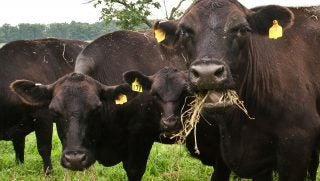Urban agriculture is undeniably a growing trend. But it’s also nothing new. I have a book from the late 1800s discussing city lot gardening in London and how to produce food in a very limited space in an urban environment. And who doesn’t remember the iconic Victory Gardens in the United States during the First and Second World Wars? Allotments have been around worldwide for centuries. The concept of feeding your family and community, even where there isn’t access to acreage is a testament to humanity’s will to provide and produce the most basic necessities to survive.
I have been involved with numerous projects in cities, small towns, growing suburbs, etc., that fit the definition of urban agriculture. One of my favorite projects was in a town just south of mine installing gardens on Habitat for Humanity lots. One lot in particular was across from a senior center. A man by the name of Mr. Byrne lived just a few houses down from the garden and the senior center. He stopped by during the installation to check out the project. We told him what we were doing, and he shared that, even at 92, he would be more than happy to “keep an eye on things” and tend the garden. His wife had died a year earlier, and I could tell he was eager to find something to pass the time. I was also very confident in his ability to get the job done. He had served in WWII with the 25th Infantry Division, and I was fairly certain he could handle operations at the garden. In the time we were there, senior citizens would trickle over to the garden and share memories of their own gardens and tips on growing. They also got to take home the harvest.
Years later, I still remember Mr. Byrne and what that garden meant to him and the people in his community.
I tell you this because connecting with the community is such an important aspect of urban agriculture. But I also want to point out that most people think of community gardens when the topic of urban ag comes up. For the most part, I believe community gardens exist as a social endeavor, an opportunity to bring people together and with some of those gardens being very successful and others simply failing to produce much in yield or engagement.
Is there an opportunity to significantly produce enough to feed a community in an urban landscape? In my opinion, yes, if it is done properly. Vertical farming and indoor hydroponic farms done to scale are pretty impressive. However, they are also limited in the variety of fruits and vegetables they can produce. Unfortunately, even with the good I have seen in these projects, there is still an abundance of misinformation.
Urban ag amid ‘Big Ag’
What I am constantly hearing is that urban agriculture is presented as an alternative of sorts to “Big Ag” or monoculture. There is a meshing of agricultural terms leading to the spread of misinformation and basic understanding of agriculture. I constantly find the need to remind people that “Organic” does not mean no chemicals are used, “seedless varieties” are not the result of modern genetic engineering (or “GMO”), there is no such thing as “chemical free,” and Monsanto (it is Bayer now!) is not “sneaking” genetically modified seeds into seed packets at the local nursery. Yet these ideas are being perpetuated in an educational setting. I’ve had urban farmers tell me they don’t want to plant just one or two varieties (to ensure significant yield) on a small lot because they are “against monoculture.” Wow. OK.
I saw the following comment on a popular urban ag page I follow:
“It would be nice if we could go back to growing Heirloom fruits and veggies with seeds instead of eating seedless, GMO garbage food our government feeds us.”
What bothers me most is the misinformation. Without proper education and understanding the science behind growing food, there can be no accurate projection of what’s possible, therefore misconstruing the ultimate effectiveness of addressing food access and food insecurity. You can’t feed someone with your feelings.
You can find example after example of how the next urban agriculture project is revolutionary. Look to foodie-based organizations and those groan-inducting food documentaries that try their darndest to paint modern agriculture in every bad light possible. From rooftop “farms” to hydroponic microgreens in an abandoned industrial space.
Conventional agriculture is so vilified, it’s nearly impossible to have conversations. This is especially true in an urban setting, where you regularly hear that city planners and urban landscape architects have such a greater influence on food access than the “Big Players” in our food system. When I started Brandywine Creek Farms, I wanted to be a part of that food access piece. A major piece of the food insecurity problem is access — in fact, it seems that the underlying issue that almost every urban farm launches its mission on is food access. But are urban farms really able to address food access? Often those working in urban environments are the first to call modern agriculture unsustainable, yet the data that we currently have not only runs opposite that line of thinking, there is strong data showing that urban centers as they are currently planned are indeed the one true unsustainable feature of the American landscape.
The reality of urban farming
Urban farming as it is being executed now is more about ideology than it is about agriculture itself, and in some cases it actually leads to gentrification of areas where demographics of people are forced out that it was originally intended to help.
Agronomy, horticulture, and basic farm economics are typically not at the forefront of an urban farm. A lot of the urban farms that I have visited operate with inefficient methodology. I’d argue that bad methodology and ideology have infected much of urban agriculture like a virus — and like a virus, they help spread misinformation about agriculture.
I have worked on and consulted at several urban farm operations. One farm I visited had 12 chickens, and the person running the farm explained how they made an organic foliar spray from chicken manure tea. Yikes! I didn’t ask if they charge more for produce with E. coli or Salmonella sprayed on it. The other thing I noticed is all the different varieties of fruits and vegetables being grown. Urban ag space is valuable, and I noticed eight melon plants taking up a lot of real estate in a small area.
The data part of urban farming is easy: Most urban farms are yielding hundreds of pounds of each specific crop. How impactful is that? One farm I visited boasted its yield at just over 4,000 pounds of fruits and vegetables. I did confirm, this was harvested crops, not counting any loss due to insect and disease pressure. This was on just under one quarter of an acre, and this was about the average size and harvests of the urban farms I visited.
According to Delish.com, the average American consumes 278 pounds of fruits and 415 pounds of vegetables. So if the urban farm is all about food sovereignty, then it can feed 5.8 people. Theoretically a city with around 500,000 residents would require more than 10,000 acres of urban farming to meet its needs entirely based on the yields I have seen.
Besides using inefficient methodologies or wanting people to live on leafy and micro greens, the 800-pound gorilla in the room with urban agriculture is the microeconomics principle of economy of scale. The urban farms producing a lot (at least by their standards) still need to charge premium-to-above-premium prices to survive. There is absolutely nothing wrong with a farmer charging premiums or above premium as long as there is a buyer, but what if those buyers are not in your market.
I spoke to Jon Whitesel, who ran Circle City Farms in Indianapolis, raising broilers and rabbits and growing produce. Whitesel’s decision to close his urban farm had nothing to do with him not being a savvy businessman — actually quite the opposite. He understood supply and demand as well as economy of scale.
“Well … I ran out of cash and couldn’t sell my products,” said Whitesel, who was working with just under and acre of land. “It cost me over $12 to produce a meat bird based on the labels customers wanted (free-range, non-GM/non-medicated feed). I guess I don’t know where to find people who can afford a $25 broiler. I thought we could make a small profit with a home-based urban farm business, but we just don’t have the scale required for it to make sense.”
The issue is that urban farming — at least on the surface and in most online statements — centers on their self-ascribed mission to address food insecurity and provide food access — and that never really comes to fruition. Access is not just about a lack of food, it can also be about the price of food. So unless they are subsidized through municipal grants or nonprofit charity, their costs will always be higher than traditional rural farms. Their models are always limited by economies of scale. Very few urban centers have land just sitting ready to be expanded into growing areas without a lot of improvements. Soil quality can limit their ability to grow food safely due to the high levels of lead and arsenic found in many urban areas. The common use of organic and holistic approaches in urban ag, undeniably contribute to low yields.
So are there any pros to urban ag outside of feeding your own family or a few neighbors? Yes! And they far outweigh the cons. Education and ag advocacy, especially in terms of getting young people interested in agriculture, are biggies. There’s nothing more rewarding than getting a group of teenagers interested in growing food or having preschoolers ask you to drive a tractor “just one more time” and watch their faces light up as you work the ground. This is where urban agriculture needs to be taken seriously. Educational and occupational opportunities abound.
Yet urban ag has been dismissed widely by the agricultural industry as whole, often because of the rhetoric heard by a lot of the people doing it. And it would be a mistake to ignore or dismiss that part of the industry. Those of us who happen to farm near a municipality that has urban ag should get involved. Our voices need to be heard, not because they are more important, but because we can offer them a different perspective. I have experienced this first hand. I have worked on several urban ag projects and had the privilege of being able to hire those who started in urban agriculture onto my farm. It is amazing how much urban farmers and rural farmers can learn about different perspectives.
I see the future of agriculture with training opportunities not just in rural America, but also in urban settings, giving us another pool to recruit future generations of farmers. Modern agriculture needs to be involved in urban ag. Push through the rhetoric and connect at the individual level. Invite them to your farm! Show them what your farm really does, giving them a reality free from bias. If possible, partner with them.
Jonathan Lawler operates Brandywine Creek Farms in Indiana and is an advocate for hunger relief and agriculture. He is working on a TV show called Punk Rock Farmer coming in the spring. His motto is FARM OR DIE.



